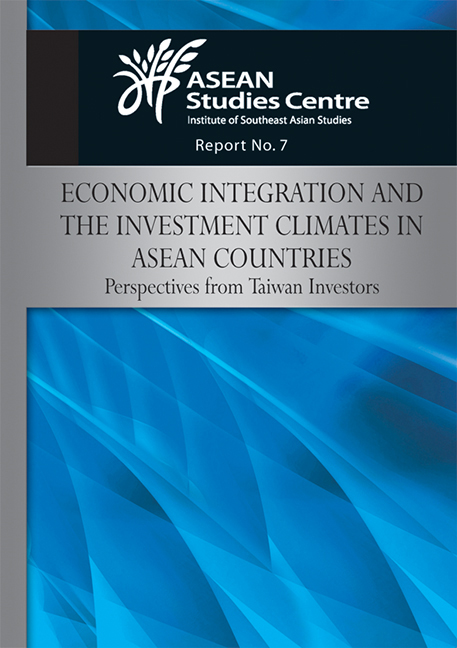 Economic Integration and the Investment Climates in ASEAN Countries
Economic Integration and the Investment Climates in ASEAN Countries from II - Background Papers
Published online by Cambridge University Press: 21 October 2015
Introduction
With regionalism gaining strength, Free Trade Agreements (FTAs) have emerged to be a reality all over the world. It is seen as an action by governments to liberalize or facilitate trade and investment on a bilateral basis through detailed negotiations. In Asia, the Association of Southeast Asian Nations (ASEAN) is fast emerging as an integration hub for FTAs by forging economic ties with China, Japan, Korea, India, Australia and New Zealand. What are the perceived benefits and challenges of these FTAs and how can they be building blocks for regional integration?
This paper attempts to answer these questions, starting with the need for FTAs, followed by a summary of the different types of ASEAN FTAs. It then summarizes some salient characteristics of ASEAN FTAs, followed by a discussion on perceived benefits and concerns. Subsequently, it elaborates on the implications of ASEAN FTAs on the process of economic integration in the region. Finally, it concludes by giving some policy recommendations.
Need for an ASEAN FTA
ASEAN was getting frustrated with the slow pace of the World Trade Organization (WTO) or Doha negotiations. It was also losing interest with the lacklustre momentum in the Asia Pacific Economic Cooperation (APEC). At the same time, as the FTA networks were growing in the United States and the European Union, ASEAN countries feared that the success of the Euro Area and the North American Free Trade Agreement (NAFTA) might dominate the global trading system. Hence, to increase their bargaining power in the global trading arena and to compensate the lack of multilateral trade liberalization, ASEAN thought of uniting together.
Secondly, the 1997–98 financial crisis taught an important lesson that ASEAN needs to strengthen economic cooperation with the neighbouring countries. The region must develop a “self-help” mechanism for better economic and financial management.
To save this book to your Kindle, first ensure [email protected] is added to your Approved Personal Document E-mail List under your Personal Document Settings on the Manage Your Content and Devices page of your Amazon account. Then enter the ‘name’ part of your Kindle email address below. Find out more about saving to your Kindle.
Note you can select to save to either the @free.kindle.com or @kindle.com variations. ‘@free.kindle.com’ emails are free but can only be saved to your device when it is connected to wi-fi. ‘@kindle.com’ emails can be delivered even when you are not connected to wi-fi, but note that service fees apply.
Find out more about the Kindle Personal Document Service.
To save content items to your account, please confirm that you agree to abide by our usage policies. If this is the first time you use this feature, you will be asked to authorise Cambridge Core to connect with your account. Find out more about saving content to Dropbox.
To save content items to your account, please confirm that you agree to abide by our usage policies. If this is the first time you use this feature, you will be asked to authorise Cambridge Core to connect with your account. Find out more about saving content to Google Drive.